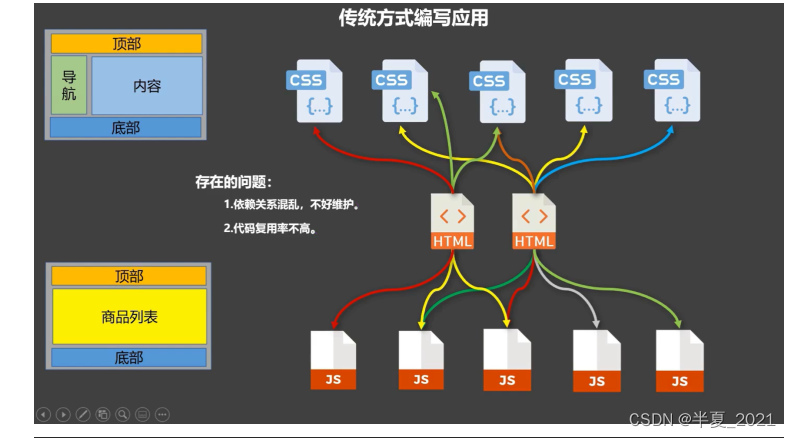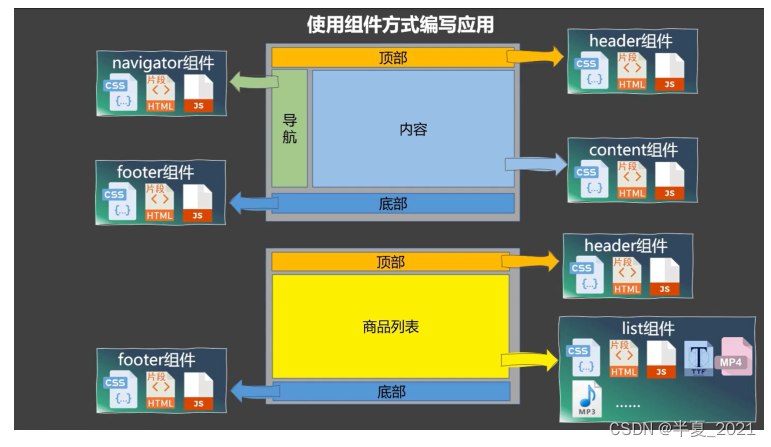1.模块与组件、模块化与组件化


模块
a.理解: 向外提供特定功能的js程序,一般就是一个JS文件
b.为什么: js 文件很多很复杂
c.作用: 复用、简化js的编写,提高js运行效率
组件
a.定义: 用来实现局部功能的代码和资源的结合(html/css/js/image…)
b.为什么: 一个界面的功能很复杂
c.作用: 复用编码,简化项目编码,提高运行效率
模块化
当应用中的js都以模块来编写,那这个应用就是一个模块化的应用。
组件化
当应用中的功能都是多组件的方式来编写的,那这个应用就是一个组件化的应用。
2.非单文件组件
非单位件组件: 一个文件中包含有n个组件
单文件组件: 一个文件中只包含有1个组件
1. 基本使用
Vue中使用组件的三大步骤:
1.定义组件
- 使用Vue.extend(options) 创建,其中 options 和 new Vue(options) 时传入 options 几乎一样,但也有点区别:
- el 不用写,因为最终所有的组件都要经过一个vm的管理,由vm中的el才决定服务哪个容器
- data 必须写成函数,避免组件被复用时,数据存在引用关系。
2.注册组件
a.局部注册: new Vue() 的时候options 传入 components选项
b.全局注册: Vue.components(‘组件名’,组件)
3.使用组件
编写组件如
<title>基本使用</title>
<script type="text/javascript" src="../js/vue.js"></script>
<div id="root">
<h2>{
{
msg}}</h2><hr>
<!-- 第三步:编写组件标签 -->
<school></school><hr>
<student></student><hr>
<hello></hello><hr>
</div>
<div id="root2">
<hello></hello>
</div>
<script type="text/javascript">
Vue.config.productionTip = false
//第一步:创建school组件
const school = Vue.extend({
// el:'#root', //组件定义时,一定不要写el配置项,
// 因为最终所有的组件都要被一个vm管理,由vm决定服务于哪个容器
template: `
<div class="demo">
<h3>学校名称:{
{
schoolName}}</h3>
<h3>学校地址:{
{
address}}</h3>
<button @click="showName">点我提示学校名</button>
</div>
`,
data() {
return {
schoolName: '尚硅谷',
address: '北京昌平'
}
},
methods: {
showName() {
alert(this.schoolName)
}
},
})
//第一步:创建student组件
const student = Vue.extend({
template: `
<div>
<h3>学生姓名:{
{
studentName}}</h3>
<h3>学生年龄:{
{
age}}</h3>
</div>
`,
data() {
return {
studentName: '张三',
age: 18
}
}
})
//第一步:创建hello组件
const hello = Vue.extend({
template: `
<div>
<h3>你好啊!{
{
name}}</h3>
</div>
`,
data() {
return {
name: 'cess'
}
}
})
//第二步:全局注册组件
Vue.component('hello', hello)
//创建vm
new Vue({
el: '#root',
data: {
msg: '你好啊!'
},
//第二步:注册组件(局部注册)
components: {
school,
student
}
})
new Vue({
el: '#root2',
})
</script>
2.组件注意事项
关于组件名
- 一个单词组成
- 第一种写法(首字母小写):school
- 第二种写法(首字母大写): School
- 多个单词组成
- 第一种写法(kebab-case 命名) : my-school
- 第二种写法(CamelCase 命名):MySchool(需要Vue脚手架支持)
- 备注
- 组件名尽量回避HTML中已有的元素名称,例如 h2,H2都不行
- 可以使用name配置项指定组件在开发者工具中呈现的名字
关于组件的标签
- 第一种写法:
- 第二种写法: (需要脚手架支持)
- 备注: 不适用脚手架时,会导致后续组件不能渲染
一个简写方式: const school = Vue.extend(options) 可简写为 const school = options, 因为父组件components 引入的时候会自动创建
<title>几个注意点</title>
<script type="text/javascript" src="../js/vue.js"></script>
<div id="root">
<h2>{
{
msg}}</h2>
<school></school>
</div>
<script type="text/javascript">
Vue.config.productionTip = false
//定义组件
const school = Vue.extend({
name: 'atguigu', // 组件给自己起个名字,用于在浏览器开发工具上显示
template: `
<div>
<h3>学校名称:{
{
name}}</h3>
<h3>学校地址:{
{
address}}</h3>
</div>
`,
data() {
return {
name: '电子科技大学',
address: '成都'
}
}
})
new Vue({
el: '#root',
data: {
msg: '欢迎学习Vue!'
},
components: {
school
}
})
</script>
3.组件的嵌套

<title>组件的嵌套</title>
<script type="text/javascript" src="../js/vue.js"></script>
<div id="root"></div>
<script type="text/javascript">
Vue.config.productionTip = false
//定义student组件
const student = Vue.extend({
name: 'student',
template: `
<div>
<h4>学生姓名:{
{
name}}</h4>
<h4>学生年龄:{
{
age}}</h4>
</div>
`,
data() {
return {
name: '尚硅谷',age: 18}}
})
//定义school组件
const school = Vue.extend({
name: 'school',
template: `
<div>
<h3>学校名称:{
{
name}}</h3>
<h3>学校地址:{
{
address}}</h3>
<student></student>
</div>
`,
data() {
return {
name: '尚硅谷',address: '北京'}},
//注册组件(局部)
components: {
student }
})
//定义hello组件
const hello = Vue.extend({
template: `<h3>{
{
msg}}</h3>`,
data() {
return {
msg: '欢迎来到尚硅谷学习!'}}
})
//定义app组件
const app = Vue.extend({
template: `
<div>
<hello></hello>
<school></school>
</div>
`,
components: {
school, hello }
})
//创建vm
new Vue({
el: '#root',
template: '<app></app>',
//注册组件(局部)
components: {
app }
})
</script>
4.VueComponents
- schol 组件本质是一个名为 VueComponent 的构造函数,且不是程序员定义的,而是 Vue.extend() 生成的
- 我们需要写或,Vue解析时会帮我们创建school组件的实例对象,即Vue帮我们执行的 new VueComponent(options)
- 每次调用 Vue.extend, 返回的都是一个全新的 VueComponent ,即不同组件是不同的对象。
- 关于this指向
- 组件配置中 data 函数、methods函数 、watch函数、computed中的函数,他们的this均是 VueComponent 实例对象。
- new Vue(options) 配置中: data函数、methods函数、watch函数、computed中的函数,他们是this均是 Vue实例对象。
- VueComponent 的实例对象,以后简称 vc (组件实例对象) Vue 的实例对象,以后简称vm
<title>VueComponent</title>
<script type="text/javascript" src="../js/vue.js"></script>
<div id="root">
<school></school>
<hello></hello>
</div>
<script type="text/javascript">
Vue.config.productionTip = false
// 定义school组件
const school = Vue.extend({
name: 'school',
template: `
<div>
<h2>学校名称:{
{
name}}</h2>
<h2>学校地址:{
{
address}}</h2>
<button @click="showName">点我提示学校名</button>
</div>
`,
data() {
return {
name: '尚硅谷',address: '北京'}},
methods: {
showName() {
console.log('showName', this)}},
})
const test = Vue.extend({
template: `<span>atguigu</span>`
})
// 定义hello组件
const hello = Vue.extend({
template: `
<div>
<h2>{
{
msg}}</h2>
<test></test>
</div>
`,
data() {
return {
msg: '你好啊!'}},
components: {
test }
})
// console.log('@',school)
// console.log('#',hello)
// 创建vm
const vm = new Vue({
el: '#root',
components: {
school, hello }
})
</script>
5.一个重要的内置关系

3 单文件组件
School.vue
<template>
<div id='Demo'>
<h2>学校名称:{
{
name}}</h2>
<h2>学校地址:{
{
address}}</h2>
<button @click="showName">点我提示学校名</button>
</div>
</template>
<script>
export default {
name:'School',
data() {
return {
name:'UESTC',
address:'成都'
}
},
methods: {
showName(){
alert(this.name)
}
},
}
</script>
<style>
#Demo{
background: orange;
}
</style>
Student.vue
<template>
<div>
<h2>学生姓名:{
{
name}}</h2>
<h2>学生年龄:{
{
age}}</h2>
</div>
</template>
<script>
export default {
name:'Student',
data() {
return {
name:'cess',
age:20
}
},
}
</script>
App.vue
<template>
<div>
<School></School>
<Student></Student>
</div>
</template>
<script>
import School from './School.vue'
import Student from './Student.vue'
export default {
name:'App',
components:{
School,
Student
}
}
</script>
main.js
import App from './App.vue'
new Vue({
template:`<App></App>`,
el:'#root',
components:{
App}
})
index.html
<!DOCTYPE html>
<html lang="en">
<head>
<meta charset="UTF-8">
<meta http-equiv="X-UA-Compatible" content="IE=edge">
<meta name="viewport" content="width=device-width, initial-scale=1.0">
<title>单文件组件练习</title>
</head>
<body>
<div id="root"></div>
<script src="../../js/vue.js"></script>
<script src="./main.js"></script>
</body>
</html>